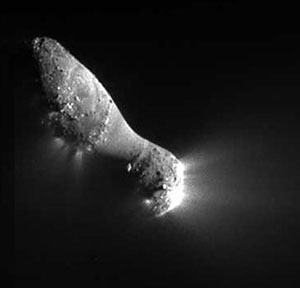How can we find out?
There are still lots of comets in the solar system. The Kuiper Belt is a
big region of icy objects, including comets, out beyond the orbit of
Neptune. Another region with even more comets is the Oort Cloud. This
region is way, way out there. It is about 30 - 50 times farther away
than the Kuiper Belt. Comets from either region sometimes go "off
course." When they do, they sometimes end up in the inner solar system
near Earth.
 A telescope called the Herschel Space Observatory recently made an
interesting discovery about a comet. Herschel studied Comet Harley 2 in
infrared light. Infrared is a kind of light we cannot see, but we may
feel as heat.
A telescope called the Herschel Space Observatory recently made an
interesting discovery about a comet. Herschel studied Comet Harley 2 in
infrared light. Infrared is a kind of light we cannot see, but we may
feel as heat.
Herschel can point toward a comet and analyze the water molecules in the fuzzy cloud of mist—or coma. This cloud is from the comet's ice boiling off its surface as it gets heated by the Sun.
But not all water is alike. There are two different types, or "isotopes" of water. One is called "heavy water" and the other is called "light water." Our ocean has a certain proportion of heavy water to light water.
Herschel found that Hartley 2 has half as much heavy water as other comets studied so far. And the proportion of heavy water to light water in this comet matches Earth's ocean! Hartley 2 is from the Kuiper Belt. All the other comets whose water "signatures" have been studied so far come from the Oort Cloud.
Scientists are surprised at this finding. They didn't think the Kuiper Belt comets were a source of our ocean. They need to study a lot more comets to be more certain.
But isn't it exciting to discover the possible source of our precious water? It's like an accidental gift from space!

Comet Hartley 2 looks a little like a peanut. It's
about 1.25 miles (2 km) long. It probably contains more than enough
water to quench your thirst after eating a ton of peanuts!
Herschel can point toward a comet and analyze the water molecules in the fuzzy cloud of mist—or coma. This cloud is from the comet's ice boiling off its surface as it gets heated by the Sun.
But not all water is alike. There are two different types, or "isotopes" of water. One is called "heavy water" and the other is called "light water." Our ocean has a certain proportion of heavy water to light water.
Herschel found that Hartley 2 has half as much heavy water as other comets studied so far. And the proportion of heavy water to light water in this comet matches Earth's ocean! Hartley 2 is from the Kuiper Belt. All the other comets whose water "signatures" have been studied so far come from the Oort Cloud.
Scientists are surprised at this finding. They didn't think the Kuiper Belt comets were a source of our ocean. They need to study a lot more comets to be more certain.
But isn't it exciting to discover the possible source of our precious water? It's like an accidental gift from space!


Komentar
Posting Komentar